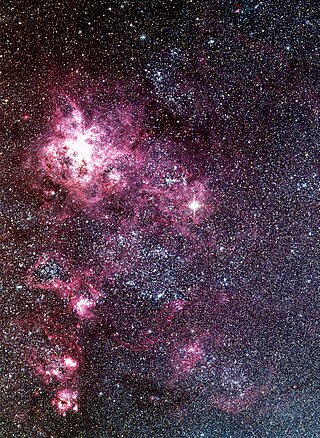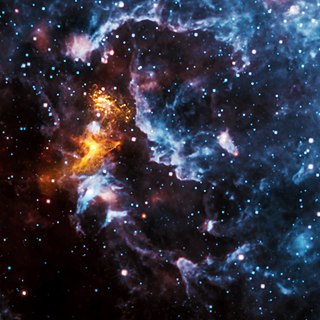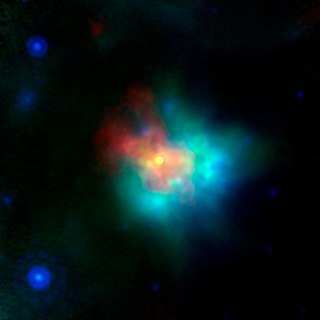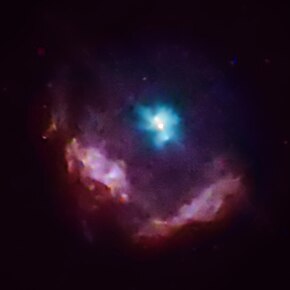
SN 1987A was a type II supernova in the Large Magellanic Cloud, a dwarf satellite galaxy of the Milky Way. It occurred approximately 51.4 kiloparsecs from Earth and was the closest observed supernova since Kepler's Supernova in 1604. Light and neutrinos from the explosion reached Earth on February 23, 1987 and was designated "SN 1987A" as the first supernova discovered that year. Its brightness peaked in May of that year, with an apparent magnitude of about 3.

A supernova remnant (SNR) is the structure resulting from the explosion of a star in a supernova. The supernova remnant is bounded by an expanding shock wave, and consists of ejected material expanding from the explosion, and the interstellar material it sweeps up and shocks along the way.

A pulsar wind nebula, sometimes called a plerion, is a type of nebula sometimes found inside the shell of a supernova remnant (SNR), powered by winds generated by a central pulsar. These nebulae were proposed as a class in 1976 as enhancements at radio wavelengths inside supernova remnants. They have since been found to be infrared, optical, millimetre, X-ray and gamma ray sources.

Einstein@Home is a volunteer computing project that searches for signals from spinning neutron stars in data from gravitational-wave detectors, from large radio telescopes, and from a gamma-ray telescope. Neutron stars are detected by their pulsed radio and gamma-ray emission as radio and/or gamma-ray pulsars. They also might be observable as continuous gravitational wave sources if they are rapidly spinning and non-axisymmetrically deformed. The project was officially launched on 19 February 2005 as part of the American Physical Society's contribution to the World Year of Physics 2005 event.

3C 58 or 3C58 is a pulsar and supernova remnant within the Milky Way. The object is listed as No. 58 in the Third Cambridge Catalogue of Radio Sources.

A pulsar is a highly magnetized rotating neutron star that emits beams of electromagnetic radiation out of its magnetic poles. This radiation can be observed only when a beam of emission is pointing toward Earth, and is responsible for the pulsed appearance of emission. Neutron stars are very dense and have short, regular rotational periods. This produces a very precise interval between pulses that ranges from milliseconds to seconds for an individual pulsar. Pulsars are one of the candidates for the source of ultra-high-energy cosmic rays.

The Crab Pulsar is a relatively young neutron star. The star is the central star in the Crab Nebula, a remnant of the supernova SN 1054, which was widely observed on Earth in the year 1054. Discovered in 1968, the pulsar was the first to be connected with a supernova remnant.

W49B is a nebula in Westerhout 49 (W49). The nebula is a supernova remnant, probably from a type Ib or Ic supernova that occurred around 1,000 years ago. It may have produced a gamma-ray burst and is thought to have left a black hole remnant.

The Vela Pulsar is a radio, optical, X-ray- and gamma-emitting pulsar associated with the Vela Supernova Remnant in the constellation of Vela. Its parent Type II supernova exploded approximately 11,000–12,300 years ago.

IC 443 is a galactic supernova remnant (SNR) in the constellation Gemini. On the plane of the sky, it is located near the star Eta Geminorum. Its distance is roughly 5,000 light years from Earth.

RX J0852.0−4622 is a supernova remnant. The remnant is located in the southern sky in the constellation Vela ("sail"), and sits inside the much larger and older Vela Supernova Remnant. For this reason, RX J0852.0−4622 is often referred to as Vela Junior. There have been a minority of suggestions that the remnant may be a spurious identification of a complicated substructure within the larger and better studied Vela SNR, but most studies accept that G266.2−1.2 is a SNR in its own right. Indeed, its detection in the high energy Teraelectronvolt range by the High Energy Stereoscopic System in 2005 is strong confirmation of such.
In astronomy, Calvera is an X-ray source in the constellation Ursa Minor, identified in 2007 as an isolated neutron star. It is one of the hottest and closest of its kind to Earth.
PSR J0855-4644 is a pulsar in the constellation Vela, and was at one time thought possibly associated with supernova remnant RX J0852.0-4622. However, this association is considered unlikely since a central compact object with better matching kinematics to the shell has been observed.
PSR J0108−1431 is a solitary pulsar located at a distance of about 130 parsecs (424 light-years) in the constellation Cetus. This pulsar was discovered in 1994 during the Parkes Southern Pulsar Survey. It is considered a very old pulsar with an estimated age of 166 million years and a rotation period of 0.8 seconds. The rotational energy being generated by the spin-down of this pulsar is 5.8 × 1023 W and the surface magnetic field is 2.5 × 107 T. As of 2008, it is the second faintest known pulsar.
Laura A. Lopez is an associate professor of astronomy at Ohio State University studying the life cycle of stars. She was awarded the Annie Jump Cannon Award in Astronomy in 2016, which is awarded by the American Astronomical Society (AAS) for outstanding research and promise for future research by a postdoctoral woman researcher.

Henize 70 (N70) is a faint emission nebula and superbubble located in the Large Magellanic Cloud. It is located in the constellation of Dorado.
A central compact object (CCO) is an x-ray source found near the center of a young, nearby supernova remnant (SNR). Given the observed x-ray flux and spectra observed from these objects, the almost certain conclusion is that CCOs are the remnant neutron stars which resulted from the recent supernova. Unlike most pulsars, CCOs generally lack pulsed radio emission or variation in the observed x-rays due to such phenomena being either nonexistent or difficult to detect. The weaker magnetic fields than most other detected neutron stars means that most of the detected x-rays are due to blackbody radiation. Confirmation that the CCO is associated with the past supernova can be done using the kinematics of the objects and matching them to the age and kinematics of the host SNR.

G299.2-2.9 is a supernova remnant found in the Milky Way, 16,000 light years from Earth. It is the remains of a Type Ia supernova. It is 4,500 years old, and is older than normal supernova remnants.

SNR G306.3-00.9, also called G306.3-0.9 is a supernova remnant located in the constellation Centaurus. It was discovered by the Swift Space Observatory in 2011.

SNR G054.1+00.3, also called G54.1+0.3, 2E 4258 and 2E 1928.3+1846 is a supernova remnant located in the constellation Sagittarius. It was identified as a supernova remnant in a study of the galactic plane in the radio continuum at wavelengths of 21 and 11 cm.














